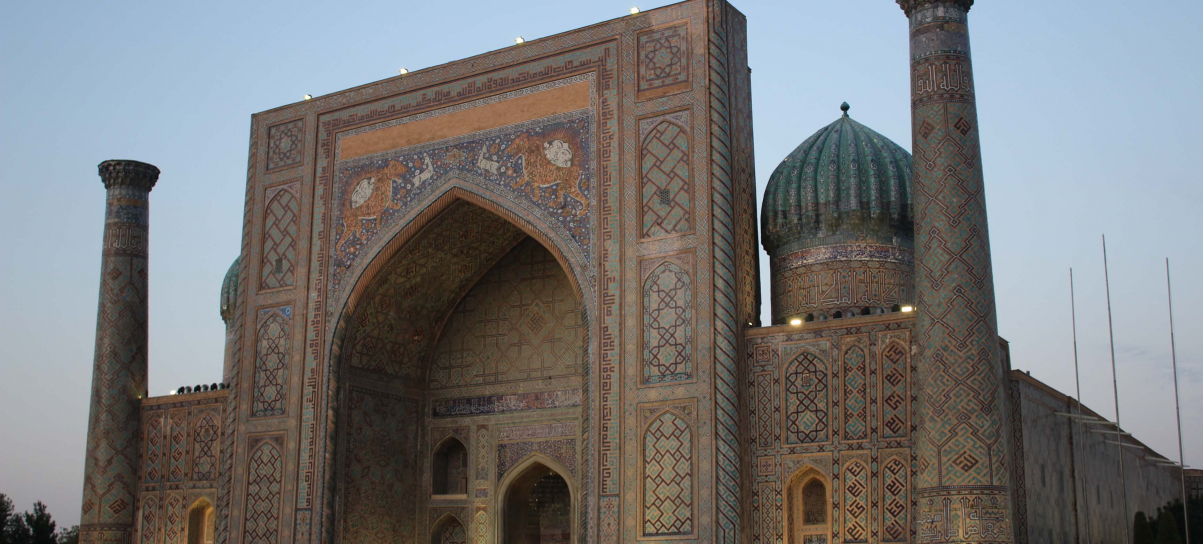Samarkand is the city of the blue domes
None of the cities of Uzbekistan was awarded with so many titles and names.
Samarkand was founded nearly 3000 years ago on the fertile valley of Zerafshan River, in the protection of Zerafshan Mountains. The area was inhabited from times immemorial as the excavations revealed. Settlement of Neolithic period was found on the territory of modern Samarkand.
The earliest records about Samarkand were made by Greek historians due to campaigns of Alexander the Great in IV с BC.
Marakanda as Greeks named it, was one of the richest and the most important cities of Sogdiana, ruled by Sovereign. The conquest of Marakanda by Greeks was bloodless but later Samarkand was one of the centers of resistance shown to Greeks.
Samarkand developed rapidly during the II-VII cc AD, when the trade on the Silk Road was on it’s peak.
 |
The Arab conquest which lasted throughout VII-VIII centuries was disastrous for local Zoroastrian population. Many times population of Samarkand rose against the invaders and many times Arabs burnt the city to ashes. Finally peace came when Khalifat was established and Samarkand enjoyed the profits of centralized governing, first from Bagdad, later from Bukhara, when Samanids established their independent state on the territory of Mowarounnahr. For 300 years Samarkand developed as the center of Enlightenment, Arts and Crafts.
In 1220 the Mongol Hordes brought destruction, chaos and death to Samarkand. The total population of the city was slaughtered, imprisoned and enslaved. When after more than 100 years, in 1334, the famous traveler Ibn Battuta, travelled to Central Asia, Samarkand was still in ruins. The recovery quickened during the rule of Timur, who made Samarkand his capital, and during whose rule Samarkand acquired the reputation of the most beautiful city of the world. Timur’s rule lasted for 35 years and all this period in Samarkand was marked by grandiose construction work fulfilled by artisans and masters from all the countries Timur conquered and unprecedented economic growth. Some of the best monuments of the period you can see still on Uzbekistan Tours. This tendency, though in lesser scale continued during the rule of his grandson Ulugbek, who was one of the greatest scholars of Central Asia. The remains of observatory of Ulugbek one can see on Uzbekistan Tour.
The Kings of Shaybanid dynasty in the XVI c, shifted capital to Bukhara and Samarkand started playing the role of the second city of the empire. The following period was marked by economic decline, internecine struggles of local lords and in the XVIII с Samarkand was in such despair that there left only around 40 families in the city. Amir of Bukhara Shahmurad repopulated Samarkand with population of more than 300 villages and towns from around Samarkand and the city revived again.
 |
In 1868 Samarkand was occupied by Russian troops of General Chernyaev and became the administrative center of Zerafshan Region of Russian Empire. From this time on starts the Russian period in the history of the city, when the Russian quarter of the city was built and city was replanned and rebuilt and new districts of Samarkand acquired European look.
In 1918 the Bolsheviks took over and Samarkand became part of Turkestan People’s Republic which turned into Uzbekistan Soviet Republic in 1924. Samarkand was declared a capital of new Republic and it continued till 1930 when capital was shifted to Tashkent.
During the Soviet period Samarkand the second largest industrial, educational and scientific center of Uzbekistan.
In 1991 Uzbekistan declared Independence and since then Samarkand is enjoying revival.
Nowadays it is world known city with very unique history and monuments preserved.
Samarkand Hotels
Samarkand Sightseeings
We recommend to see more:
Follow us on
Sign up for our newsletters
Find our latest discounted tours, updated itineraries and latest news about the region



